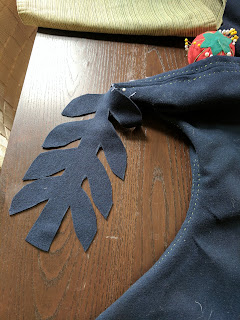 |
| we did a thing! |
The request was for a 14th-century hood as part of Laurel regalia (in place of a cloak) for Stephan of Silverforge, which would be executed as a team effort between myself and my ronin-sister Ceinwen. We had a pretty free hand, modulo the information that he'd probably rather not something in traditional Laurel green, and that he likes wearing hoods in the wacky late-14th century "chaperon" style (this is where you put the face opening of the hood on top of your head like a hat, drape the mantle along your shoulder, and wrap the liripipe around your temples).
Design Stage (March-early April)
| BNF 1586, folio 56r |
 |
| one of the Comminges laurel wreaths |
 |
| Ceinwen's initial design sketch |
The other major design element, in light of the recipient's chaperon-style tendencies, was to cut the hood's liripipe as laurel leaves, so it would form an actual laurel wreath when he wrapped it around his head. I'd never made a liripipe before, so why start with something boring and normal?
Fabric-wise, I had ten yards of a handsome navy twill that I was hoping to use, but twill wasn't going to be a great choice for a cut liripipe unless we lined and/or finished every. single. stupid. leaf; and bugger that for a game of soldiers (and, at that, I'm not sure it was Done). So, I ordered Wm. Booth's navy blue broadcloth, which, although rather a darker blue than we wanted, was perfect in the weight & behavior department. I got some silvery-blue silk from the Garment District for the lining, and Ceinwen picked up an exquisite heavy navy blue silk for the embroidered band, and off we went[2].
 |
| warning: math ahead |
I based the hood on D10597 of the Greenland finds, which was pretty exact to the proportions Stephan's lady had sent me from one of his current hoods. I spent an uncomfortable couple of hours with math and many pencil marks converting the 2mm:1cm scale in "Medieval Garments Reconstructed" into Imperial measurements, but got there eventually. The rest seemed pretty unremarkable--I made a muslin; tested it and it seemed OK; cut out hood & lining; sewed it all up[1], and did a bit of decorative top-stitching with a pale green silk; patted self smugly on the back; and then tried it on my dashing consort.
Whereupon I found the front was horribly, horribly poochy under the neck.
 |
After a requisite amount of self-flagellation, I calculated the gore size appropriate to the pattern, cut one out of muslin, opened the front seam sobbing at the destruction of my painstaking handiwork, and pinned the gore in. It worked with only a little frobbing, thankfully, so I cut out fashion fabric & lining versions and got them sewn in. (You still see some wrinkles; there will always be a little bit of that, unless you're doing a button-up hood that can be perfectly fitted to the wearer.)
 |
| tools of the trade |
 |
| When you really suck at drawing, grids help. |
I tried sketching laurel leaves after the embroidery I'd found, but this was working out poorly for me, so I got an actual bay laurel leaf out of the kitchen and traced around it. Happily, this turned out to be exactly the right proportion for my liripipe! I made a five-leaf-long repeat of the pattern (which is exactly one sheet of graph paper, imagine that) and cut out a test piece to see how it did.
Answer: pretty well, actually.
 |
| Proof-of-concept |
Embroidery Stage (May-early July)
 |
| My first wreath. About 15 hours' work I think? I'm not very fast. |
Unfortunately we ran out of time, so couldn't add pearls or bezants or bells (yes. there are hoods with bells all over them.), but we got the job done on time for transport to the event. We figure to steal it back later and fully execute our vision. Especially the pearls.
As yet, no photos have emerged from the event, but I'll add action shots as they become available.
[1] yes, of course it's all hand-sewn
[2] this is somewhat compressed. We had a lot of ordering of swatches and mailing them back and forth in here.
[3] acc. no. BC72 <3110/1> but it's not in the MoL's online collection nor can I find an image online because why would we want that

No comments:
Post a Comment